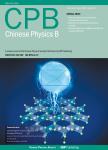Combined effects of carrier scattering and Coulomb screening on photoluminescence in InGaN/GaN quantum well structure with high In content
Combined effects of carrier scattering and Coulomb screening on photoluminescence in InGaN/GaN quantum well structure with high In content作者机构:School of MicroelectronicsShandong UniversityJinan 250100China Shandong Inspur Huaguang Optoelectronics Co.Ltd.Weifang 261061China State Key Laboratory of Crystal MaterialsShandong UniversityJinan 250100China
出 版 物:《Chinese Physics B》 (中国物理B(英文版))
年 卷 期:2021年第30卷第4期
页 面:530-534页
核心收录:
学科分类:07[理学] 08[工学] 070201[理学-理论物理] 0803[工学-光学工程] 0702[理学-物理学]
基 金:Project supported by the National Natural Science Foundation of China(Grant Nos.51672163 and 51872167) the Major Research Plan of the National Natural Science Foundation of China(Grant No.91433112)
主 题:photoluminescence carrier localization effect internal quantum efficiency growth temperature
摘 要:Photoluminescence(PL) spectra of two different green InGaN/GaN multiple quantum well(MQW) samples S1 and S2,respectively with a higher growth temperature and a lower growth temperature of InGaN well layers are analyzed over a wide temperature range of 6 K-3 30 K and an excitation power range of 0.001 mW-75 *** excitation power-dependent PL peak energy and linewidth at 6 K show that in an initial excitation power range,the emission process of the MQW is dominated simultaneously by the combined effects of the carrier scattering and Coulomb screening for both the samples,and both the carrier scattering effect and the Coulomb screening effect are stronger for S2 than those for S1;in the highest excitation power range,the emission process of the MQWs is dominated by the filling effect of the high-energy localized states for S1,and by the Coulomb screening effect for *** behaviors can be attributed to the fact that sample S2 should have a higher amount of In content in the InGaN well layers than S1 because of the lower growth temperature,and this results in a stronger component fluctuation-induced potential fluctuation and a stronger well/barrier lattice mismatchinduced quantum-confined Stark *** explanation is also supported by other relevant measurements of the samples,such as temperature-dependent peak energy and excitation-power-dependent internal quantum efficiency.



